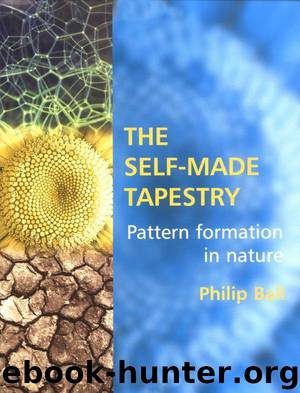The self-made tapestry: pattern formation in nature by Philip Ball

Author:Philip Ball
Language: eng
Format: epub
ISBN: 978-0198502432
Publisher: Oxford University Press
Published: 2001-10-17T16:00:00+00:00
As wavy cracks in the descending glass plates get faster, the oscillations become more pronounced, until finally they start to distort from pure 'sine waves' and develop kinks (Fig. 6.6c, d). What happened at even faster speeds depends on the temperature difference between the heater and the bath (which controls the crack-inducing stress). For a small temperature drop (between about 60 and 100°C), straight cracks actually reappear at fast speeds. But for temperature drops above about 180°C, wavy cracks at low speeds rapidly give way to branching cracks, whose patterns can be very complex. A single initial crack first forks into two, and these might then each fork into a further two branches and so on. Sometimes the branches develop wavy instabilities before forking (Fig. 6.6e). Yuse and Sano were able to map out the boundaries of the straight, wavy and branching regimes as the temperature drop and crack speed (that is, the descent speed of the strip) were altered (Fig. 6.7).
Download
This site does not store any files on its server. We only index and link to content provided by other sites. Please contact the content providers to delete copyright contents if any and email us, we'll remove relevant links or contents immediately.
The Lonely City by Olivia Laing(4730)
Animal Frequency by Melissa Alvarez(4382)
All Creatures Great and Small by James Herriot(4211)
Walking by Henry David Thoreau(3875)
Exit West by Mohsin Hamid(3764)
Origin Story: A Big History of Everything by David Christian(3631)
COSMOS by Carl Sagan(3537)
How to Read Water: Clues and Patterns from Puddles to the Sea (Natural Navigation) by Tristan Gooley(3384)
Hedgerow by John Wright(3258)
The Inner Life of Animals by Peter Wohlleben(3246)
How to Read Nature by Tristan Gooley(3229)
How to Do Nothing by Jenny Odell(3218)
Project Animal Farm: An Accidental Journey into the Secret World of Farming and the Truth About Our Food by Sonia Faruqi(3163)
Origin Story by David Christian(3132)
Water by Ian Miller(3111)
A Forest Journey by John Perlin(3018)
The Plant Messiah by Carlos Magdalena(2868)
A Wilder Time by William E. Glassley(2804)
Forests: A Very Short Introduction by Jaboury Ghazoul(2777)
